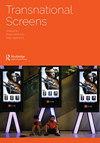Globalizing ‘a rage that never dies’ (but can’t stay the same): shifting dynamics of identification in the transnational remaking of Ju-On into The Grudge
IF 0.4
0 FILM, RADIO, TELEVISION
引用次数: 0
Abstract
ABSTRACT The Grudge was unique among transnational Japanese horror remakes due to several factors: Ju-On’s director Shimizu Takashi was retained for the Hollywood-financed version, as was its Japanese setting, even as the narrative’s protagonists were replaced with an American cast and the film’s plotlines restructured to accommodate this change. Using Iwabuchi Koichi’s notion of ‘cultural odor’ as a theoretical framework, and informed by scholarship on other J-Horror films and their transnational remakes, the explicit intentions of Ju-On/The Grudge’s producers and creators are contrasted with evidence from the texts themselves, and contextualized through an examination of critical and popular reception of the films as cross-cultural products. This investigation reveals fundamental shifts in dynamics of identification: In Ju-On the horror threat resonates with culturally proximate concerns, and the climactic sequence functions to create a circle of identification between the monster, the protagonist, and the viewer. Conversely, in The Grudge, the monster’s nature as culturally abject in relation to the central protagonist forecloses the potential for such identification, and foreignness itself becomes central to the horror affect.全球化的“永不消逝的愤怒”(但不能保持不变):在跨国翻拍《朱昂》到《怨恨》的过程中,身份认同的动态变化
《咒怨》在日本跨国恐怖电影翻拍中是独一无二的,这有几个因素:好莱坞投资的版本保留了朱安的导演高桥清水(Shimizu Takashi),以及它的日本背景,尽管叙事的主角被美国演员取代,电影的情节线也被重新调整以适应这一变化。以岩渊光一的“文化气味”概念为理论框架,并以其他日本恐怖电影及其跨国翻拍的学术研究为依据,将《朱安/怨恨》制片人和创作者的明确意图与文本本身的证据进行对比,并通过对电影作为跨文化产品的批评和大众接受的审查进行语境化。这一调查揭示了认同动态的根本转变:在《朱安》中,恐怖威胁与文化上的关注产生了共鸣,高潮序列在怪物、主角和观众之间创造了一个认同循环。相反地,在《咒怨》中,与主角相比,怪物在文化上是卑贱的,这就排除了这种认同的可能性,而异乡感本身成为了恐怖影响的核心。
本文章由计算机程序翻译,如有差异,请以英文原文为准。
求助全文
约1分钟内获得全文
求助全文
来源期刊

Transnational Screens
Arts and Humanities-Visual Arts and Performing Arts
CiteScore
0.60
自引率
0.00%
发文量
23
 求助内容:
求助内容: 应助结果提醒方式:
应助结果提醒方式:


